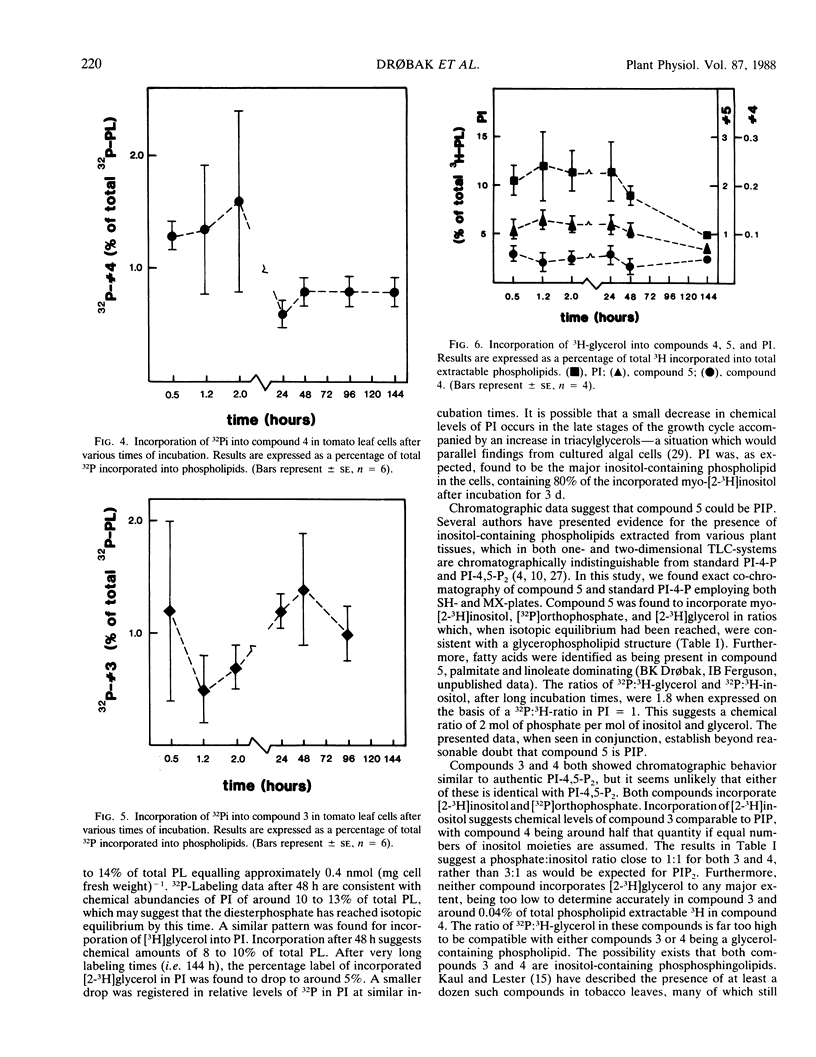Abstract
Polar lipids were extracted from suspension-cultured tomato (Lycopersicon esculentum Mill.) cells and analyzed by thin layer chromatography. Four major inositol-containing compounds were found, and incorporation of [32P]orthosphosphate, [2-3H]glycerol, and myo-[2-3H]inositol was studied. Results showed that phosphatidylinositol-monophosphate is the phospholipid in these cells displaying the most rapid incorporation of [32P]orthophosphate. We suggest that the tracer is incorporated primarily into the phosphomonoester group. Two inositol-containing lipids showed chromatographic behavior similar to phosphatidylinositol-4,5-bisphosphate when using standard thin layer chromatography techniques. The labeling pattern of these compounds, however, reveals that it is unlikely that either of these is identical to phosphatidylinositol-4,5-bisphosphate. Should phosphatidylinositol-bisphosphate be present in suspension cultured plant cells, our data indicate chemical abundancies substantially lower than previously reported.
Full text
PDF





Images in this article
Selected References
These references are in PubMed. This may not be the complete list of references from this article.
- Berridge M. J., Irvine R. F. Inositol trisphosphate, a novel second messenger in cellular signal transduction. Nature. 1984 Nov 22;312(5992):315–321. doi: 10.1038/312315a0. [DOI] [PubMed] [Google Scholar]
- Boss W. F., Massel M. O. Polyphosphoinositides are present in plant tissue culture cells. Biochem Biophys Res Commun. 1985 Nov 15;132(3):1018–1023. doi: 10.1016/0006-291x(85)91908-4. [DOI] [PubMed] [Google Scholar]
- Broekman M. J. Phosphatidylinositol 4,5-bisphosphate may represent the site of release of plasma membrane-bound calcium upon stimulation of human platelets. Biochem Biophys Res Commun. 1984 Apr 16;120(1):226–231. doi: 10.1016/0006-291x(84)91437-2. [DOI] [PubMed] [Google Scholar]
- Drøbak B. K., Ferguson I. B. Release of Ca2+ from plant hypocotyl microsomes by inositol-1,4,5-trisphosphate. Biochem Biophys Res Commun. 1985 Aug 15;130(3):1241–1246. doi: 10.1016/0006-291x(85)91747-4. [DOI] [PubMed] [Google Scholar]
- Heim S., Wagner K. G. Evidence of phosphorylated phosphatidylinositols in the growth cycle of suspension cultured plant cells. Biochem Biophys Res Commun. 1986 Feb 13;134(3):1175–1181. doi: 10.1016/0006-291x(86)90374-8. [DOI] [PubMed] [Google Scholar]
- Irvine R. F., Letcher A. J., Dawson R. M. Phosphatidylinositol phosphodiesterase in higher plants. Biochem J. 1980 Oct 15;192(1):279–283. doi: 10.1042/bj1920279. [DOI] [PMC free article] [PubMed] [Google Scholar]
- Irvine R. F. The enzymology of stimulated inositol lipid turnover. Cell Calcium. 1982 Oct;3(4-5):295–309. doi: 10.1016/0143-4160(82)90018-5. [DOI] [PubMed] [Google Scholar]
- Kaul K., Lester R. L. Characterization of Inositol-containing Phosphosphingolipids from Tobacco Leaves: Isolation and Identification of Two Novel, Major Lipids: N-Acetylglucosamidoglucuronidoinositol Phosphorylceramide and Glucosamidoglucuronidoinositol Phosphorylceramide. Plant Physiol. 1975 Jan;55(1):120–129. doi: 10.1104/pp.55.1.120. [DOI] [PMC free article] [PubMed] [Google Scholar]
- Mandal N. C., Biswas B. B. Metabolism of inositol phosphates. II. Biosynthesis of inositol polyphosphates in germinating seeds of Phaseolus aureus. Indian J Biochem. 1970 Mar;7(1):63–67. [PubMed] [Google Scholar]
- Morse M. J., Crain R. C., Satter R. L. Phosphatidylinositol Cycle Metabolites in Samanea saman Pulvini. Plant Physiol. 1987 Mar;83(3):640–644. doi: 10.1104/pp.83.3.640. [DOI] [PMC free article] [PubMed] [Google Scholar]
- Palmer S., Hawkins P. T., Michell R. H., Kirk C. J. The labelling of polyphosphoinositides with [32P]Pi and the accumulation of inositol phosphates in vasopressin-stimulated hepatocytes. Biochem J. 1986 Sep 1;238(2):491–499. doi: 10.1042/bj2380491. [DOI] [PMC free article] [PubMed] [Google Scholar]
- Reddy A. S., Poovaiah B. W. Inositol 1,4,5-trisphosphate induced calcium release from corn coleoptile microsomes. J Biochem. 1987 Mar;101(3):569–573. doi: 10.1093/jb/101.3.569. [DOI] [PubMed] [Google Scholar]
- Schumaker K. S., Sze H. Inositol 1,4,5-trisphosphate releases Ca2+ from vacuolar membrane vesicles of oat roots. J Biol Chem. 1987 Mar 25;262(9):3944–3946. [PubMed] [Google Scholar]
- Turner P. R., Sheetz M. P., Jaffe L. A. Fertilization increases the polyphosphoinositide content of sea urchin eggs. Nature. 1984 Aug 2;310(5976):414–415. doi: 10.1038/310414a0. [DOI] [PubMed] [Google Scholar]



